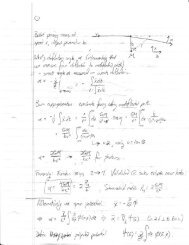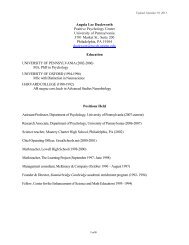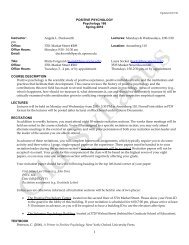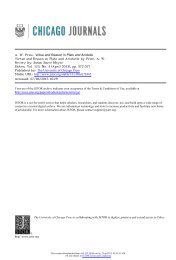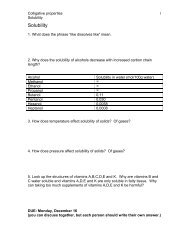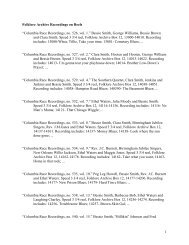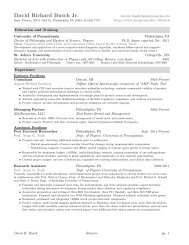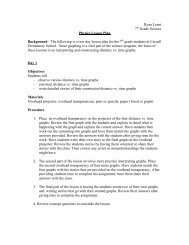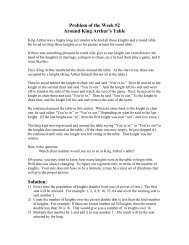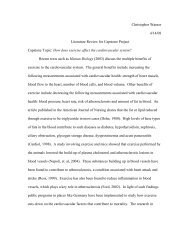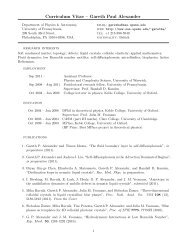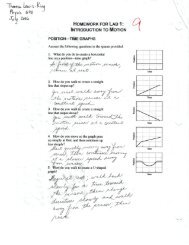Punnett Squares and Binomials
Punnett Squares and Binomials
Punnett Squares and Binomials
Create successful ePaper yourself
Turn your PDF publications into a flip-book with our unique Google optimized e-Paper software.
<strong>Punnett</strong> <strong>Squares</strong> <strong>and</strong> <strong>Binomials</strong><br />
Teacher: Paul McNally<br />
School: Carusi Middle School<br />
Class: Enriched Algebra I<br />
Lesson: Squaring a binomial (1 day)<br />
Defining the Problem: To improve students’ underst<strong>and</strong>ing of squaring a binomial.<br />
Students normally have misconceptions/problems when squaring a binomial because they<br />
think that they can distribute the power to each term in the binomial. This misconception<br />
stems from the unit on monomials, where a power is distributed to a monomial.<br />
Learning Goals: The overarching goals of this lesson will be if the students can<br />
underst<strong>and</strong> the pattern of a squared binomial by visualizing it geometrically with a<br />
<strong>Punnett</strong> square.<br />
Objectives: The students will underst<strong>and</strong> the pattern of a squared binomial using<br />
geometric representations (<strong>Punnett</strong> squares) <strong>and</strong> extend the concept by exploring the<br />
similarities between the binomial pattern <strong>and</strong> the pattern in Pascal’s triangle.<br />
Prior Knowledge: Students have learned how to multiply binomials using the FOIL<br />
pattern <strong>and</strong> multiply higher degree polynomials using the distributive property. Students<br />
have also learned about mitosis, meiosis, dominant genes, recessive genes, <strong>and</strong><br />
incomplete dominance.<br />
New Jersey Core Curriculum St<strong>and</strong>ard(s) <strong>and</strong> explanation.<br />
4.1.8 A Numerical Operations<br />
* Underst<strong>and</strong> <strong>and</strong> apply laws of exponents to simplify expressions involving<br />
numbers raised to powers. (How) Students will perform manipulations involving<br />
the laws of exponents to simplify the polynomial expressions.<br />
4.2.8 A Geometric Properties<br />
* Use geometric models to represent real-world situations <strong>and</strong> objects to solve<br />
problems using those models. (How) Students will use geometric models to<br />
solve/represent the special product of a binomial<br />
4.3.8 A Patterns <strong>and</strong> Algebra<br />
* Recognize, describe, extend, <strong>and</strong> create patterns involving whole numbers,<br />
rational numbers, <strong>and</strong> integers. (How) Students will recognize the pattern of a<br />
squared binomial <strong>and</strong> extend it to Pascal’s triangle.<br />
4.3.8.D Patterns <strong>and</strong> Algebra<br />
*Create, evaluate, <strong>and</strong> simplify algebraic expressions involving variables. (How)<br />
Students will simplify squared binomial expressions.<br />
4.4.8 B Data Analysis <strong>and</strong> Probability<br />
*Interpret probabilities as ratios, percents, <strong>and</strong> decimals. (How) Students will<br />
observe <strong>Punnett</strong> squares to determine probability <strong>and</strong> use algebra to verify the<br />
probability.<br />
4.5. ABCD Mathematical Processes
*A, Learn mathematics through problem solving, inquiry, <strong>and</strong> discovery; B,<br />
Communicate their mathematical thinking coherently <strong>and</strong> clearly to peers,<br />
teachers, <strong>and</strong> others, both orally <strong>and</strong> in writing; C, Recognize recurring themes<br />
across mathematical domains (e.g., patterns in number, algebra, <strong>and</strong> geometry);<br />
D, Recognize that mathematical facts, procedures, <strong>and</strong> claims must be justified.<br />
Anticipation of Questions: I expect students to have difficulty remembering the pattern of<br />
a squared binomial. Some of the questions I anticipate the students asking are as follows:<br />
1. Why can’t you just distribute the power like we did when we did monomials?<br />
2. Why are there two middle terms when you square a binomial?<br />
3. How is a <strong>Punnett</strong> square similar to a squared binomial?<br />
*More questions will arise as the lesson proceeds.<br />
Vocabulary:<br />
1. Binomial<br />
2. Polynomial<br />
3. <strong>Punnett</strong> square<br />
4. Homozygous<br />
5. Heterozygous<br />
Motivational questions:<br />
1. Why do we resemble one parent more than they other?<br />
2. Why is there sometimes a mix of looking like both parents?<br />
Phase of Inquiry:<br />
<strong>Punnett</strong> squares are diagrams that are used to show the possible ways that genes<br />
can combine at fertilization. In a <strong>Punnett</strong> square, dominant genes are shown in capital<br />
letters. Recessive genes are shown with lowercase letters. Letters representing parents’<br />
genes are placed on the two of the outer sides of the <strong>Punnett</strong> square. Letters inside the<br />
squares of the <strong>Punnett</strong> square show the possible gene combinations of their offspring.<br />
The <strong>Punnett</strong> square below represents an area model of a cross between two<br />
heterozygous pea plants. The <strong>Punnett</strong> square shows all the possible outcomes of there<br />
offspring <strong>and</strong> the probability of each scenario. Let T represent the dominant gene for<br />
tallness, <strong>and</strong> let t represent the recessive gene for shortness. Notice that there are three<br />
dark green squares inside the <strong>Punnett</strong> square. The reason for this is because T is the<br />
dominant gene.<br />
T<br />
T<br />
TT<br />
t<br />
Tt<br />
t<br />
Tt<br />
tt<br />
Q: By observing the <strong>Punnett</strong> square, what is the probability of having a tall pea plant<br />
from this cross, <strong>and</strong> the probability of having a short pea plant?
⎛ 1<br />
A: Since each square represents ⎜<br />
⎞ ⎝ 4⎠ ⎟ (25%) of the total area, the probability of getting a<br />
1<br />
tall pea plant is 3 × ⎛ ⎝ ⎜ ⎞<br />
⎛ 1<br />
⎟ = 75%. Therefore, the probability of short pea plant is ⎜ ⎞ 4⎠<br />
⎝ 4⎠ ⎟ (25%).<br />
• After an introduction into <strong>Punnett</strong> squares, I would explain to them that <strong>Punnett</strong><br />
squares are an excellent geometric representation of “squaring a binomial”. Learning the<br />
special pattern of “squaring a binomial” can be very beneficial because it will save time<br />
<strong>and</strong> make “factoring” <strong>and</strong> “completing the square” much easier to underst<strong>and</strong> in the<br />
future. I anticipate that most students will have the following misconception because they<br />
2 2 2<br />
are familiar with distributing a power in a monomial: ( a + b)<br />
≠ a + b<br />
Introduction of Special Products of Polynomials<br />
2 2 2<br />
( a + b)<br />
= a + 2 ab + b<br />
• The area model shown below gives a geometric representation of a squared<br />
2 2 2<br />
binomial: ( a + b)<br />
= a + 2 ab + b<br />
a<br />
a<br />
a2<br />
b<br />
ab<br />
b<br />
ab<br />
b2<br />
• The <strong>Punnett</strong> square below is an example of incomplete dominance. It is an area<br />
model that shows the possible results of crossing two pink snapdragons, each with one<br />
red gene R <strong>and</strong> one with one white gene W. Each parent snapdragon passes along only<br />
one gene for color to its offspring.<br />
R<br />
RW<br />
(pink)<br />
W<br />
RW<br />
(pink)<br />
R<br />
W<br />
RR<br />
(red)<br />
RW<br />
(pink)<br />
RW<br />
(pink)<br />
WW<br />
(white)<br />
Q: How can the square of a binomial can be used to model this <strong>Punnett</strong> square?<br />
A: Each parent snapdragon has half red genes <strong>and</strong> half white genes. You can model the<br />
genetic makeup of each parent as 05 . R + 05 . W . The genetic makeup of the offspring can<br />
2<br />
be modeled by ( 05 . R + 05 . W)<br />
( 05 . R + 05 . W) = ( 05 . R) + 2( 05 . R)( 05 . W) + ( 05 . W)<br />
2 2 2
= 0. 25R 2 + 05 . RW + 0.<br />
25W<br />
2<br />
(red) (pink) (white)<br />
Q: What does this model tell use about the probability of each event, <strong>and</strong> how is this<br />
model consistent with the <strong>Punnett</strong> square?<br />
A: This model implies that the probability of a red snapdragon offspring will be<br />
⎛ 1<br />
⎜<br />
⎞ ⎝ 4⎠ ⎟ ⎛ 1<br />
(25%), a pink offspring will be ⎜<br />
⎞ ⎝ 2⎠ ⎟ ⎛ 1<br />
(50%), <strong>and</strong> a white offspring will be ⎜ ⎞ ⎝ 4⎠ ⎟ (25%).<br />
This is consistent with the area model because 25% of the area is red (RR), 50% of the<br />
area is pink (RW), <strong>and</strong> 25% of the area is white (WW).<br />
Closure/Extension:<br />
Q: This is an amazing that pattern because it can be shown algebraically <strong>and</strong><br />
geometrically. Now that you have learned the pattern of a squared binomial, can anyone<br />
think of this pattern of coefficients 1 : 2 : 1 in another part of mathematics?<br />
A: Pascal’s triangle. Notice the coefficients when you perform various powers to<br />
the same binomial. The pattern of coefficients represents Pascal’s triangle. Pascal’s<br />
triangle is a pattern formed by adding two adjacent numbers <strong>and</strong> writing the solution<br />
below the two numbers.<br />
( a + b)<br />
0<br />
= 1<br />
( a + b)<br />
1 = 1 1<br />
( a + b)<br />
( a + b)<br />
( a + b)<br />
2<br />
3<br />
4<br />
= 1 2 1<br />
= 1 3 3 1<br />
= 1 4 6 4 1<br />
… = ……<br />
Q: Using Pascal’s triangle, determine the coefficients of a binomial that is raised<br />
to the 5 th power? 6 th power?<br />
A: 5 th power = 1 5 10 10 5 1<br />
6 th power = 1 6 15 20 15 6 1
Enriched Algebra I<br />
<strong>Punnett</strong> Square Activity<br />
Name: __________________<br />
Date: ___________________<br />
1. In tigers, the normal color gene C is dominant <strong>and</strong> the white color gene c is recessive.<br />
This means that a tiger whose color genes are CC or Cc will have normal coloring, <strong>and</strong> a<br />
tiger whose color genes are cc will be white.<br />
a. Create a <strong>Punnett</strong> square that represents the cross between two heterozygous ( Cc × Cc)<br />
tigers.<br />
b. Find a model that can be used to represent the <strong>Punnett</strong> square <strong>and</strong> write the model as a<br />
polynomial.<br />
c. Use the polynomial to determine what percent of the offspring will have normal<br />
coloring? What percent will be white?<br />
2. In chickens, there is an incomplete dominance between the normal-feathered gene F<br />
<strong>and</strong> the frizzle-feathered gene f.<br />
a. Create a Punnet square that represents the cross between two heterozygous ( Ff × Ff )<br />
chickens.<br />
b. Find a model that can be used to represent the <strong>Punnett</strong> square <strong>and</strong> write the model as a<br />
polynomial.<br />
c. Use the polynomial to determine the probability of all possible outcomes.
3. One cat carries heterozygous, long-haired traits (Ss), <strong>and</strong> its mate carries homozygous<br />
short-haired traits (ss). Use a <strong>Punnett</strong> square to determine the probability of one of their<br />
offspring having long hair.<br />
Probability: _______________<br />
4. One cat carries homozygous, long-haired traits (SS), <strong>and</strong> its mate carries homozygous<br />
short-haired traits (ss). Use a <strong>Punnett</strong> square to determine the probability of one of their<br />
offspring having short hair.<br />
Probability: _______________<br />
5. One flower is heterozygous red (Rr) <strong>and</strong> it is crossed with a homozygous white (rr)<br />
plant. Use a <strong>Punnett</strong> square to determine the probability of one of their offspring having a<br />
red color.<br />
Probability: _______________<br />
6. One flower is homozygous red (RR) <strong>and</strong> it is crossed with a homozygous white (rr)<br />
plant. Use a <strong>Punnett</strong> square to determine the probability of one of their offspring having a<br />
white color.<br />
Probability: _______________



